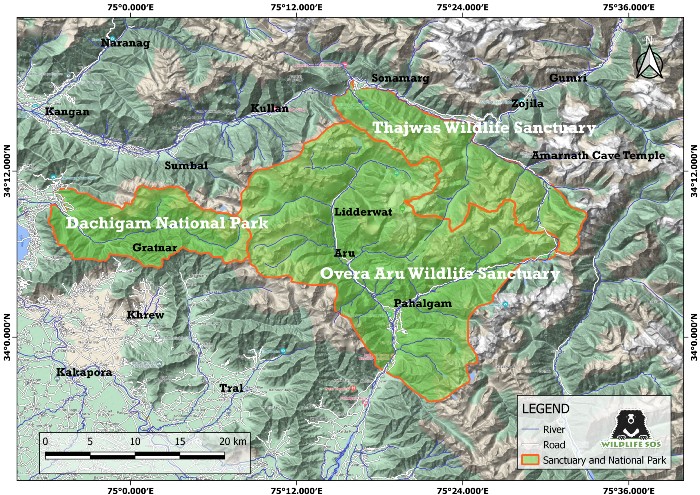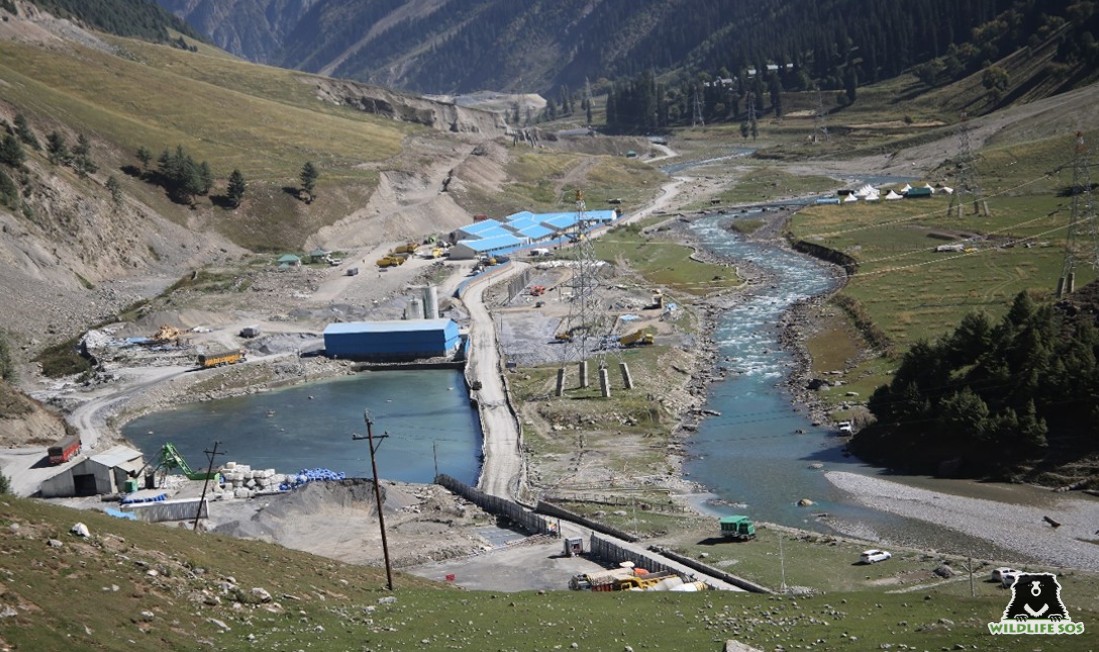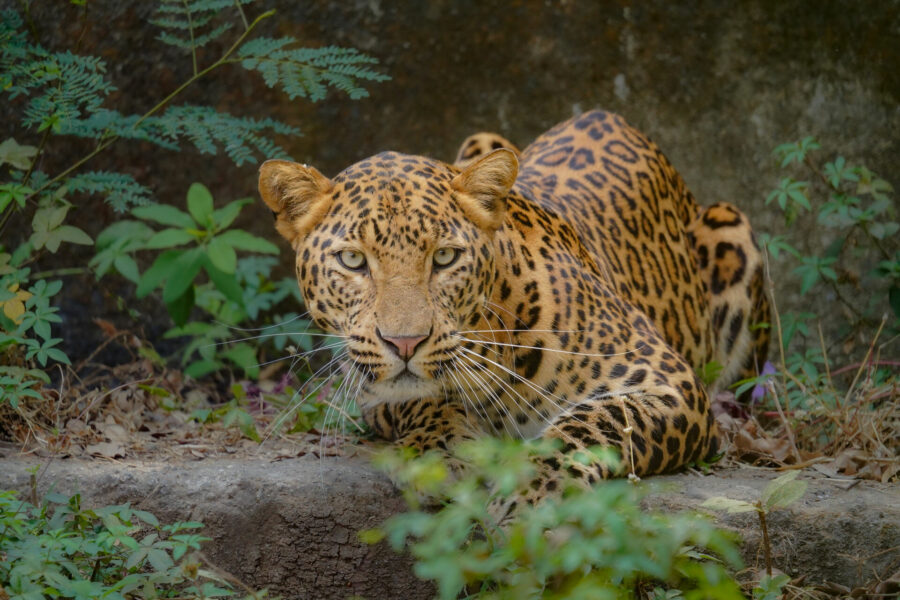Hidden among the craggy peaks and steep slopes of Central Asia, the silent ‘ghost of the mountains’ prowls its rugged terrain with stealth and grace. With thick grey fur tinged with yellow and dark rosettes that camouflage perfectly against the snowy, rocky environment, the snow leopard (Panthera uncia) has evolved to thrive in some of the harshest habitat on Earth. As a crucial apex predator, the snow leopard plays a vital role in maintaining the balance of these mountainous ecosystems.

The habitat of the snow leopard spans across 12 Asian countries: Afghanistan, Bhutan, China, India, Kazakhstan, Kyrgyzstan, Mongolia, Nepal, Pakistan, Russia, Tajikistan, and Uzbekistan. In India, these majestic cats are found in the high alpine regions of the Himalayas, typically above the tree line, at elevations between 3,200 and 5,200 m above sea level.

Despite their elusive nature, snow leopards face significant threats from the increasing footprint of human activities and shifting climates. Habitat loss, degradation, human encroachment, retaliatory killings due to human-wildlife conflict, reduced prey availability, poaching — all pose serious risks to their survival. With an estimated 2,710 to 3,386 snow leopards remaining in the wild, the International Union for Conservation of Nature (IUCN) lists them as ‘Vulnerable’ on its Red List.
Research in Thajwas Wildlife Sanctuary
During the summer and autumn seasons of 2021, while conducting brown bear research in Kashmir, the Wildlife SOS team embarked on an intriguing journey to uncover what was unknown about snow leopards in and around the Thajwas Wildlife Sanctuary. This region had experienced numerous negative interactions with snow leopards, as the cats frequently preyed on the livestock of local communities.

The study aimed to understand the distribution, diet, and complex interactions between humans and leopards in these remote regions, contributing to the formulation of an effective conservation plan for snow leopards in India. Key findings from this study are detailed below.
Snow Leopard Distribution
The presence of snow leopards was confirmed through indirect sighting signs like scats, scrapes and pugmarks recorded on hill slopes and valley edges of Zoji La and Panchtarni. Predatory attempts on livestock were also recorded via questionnaire surveys and were used to comprehend snow leopard movements.

The Wildlife SOS research team surveyed over 355.5 km of trails and discovered that these majestic cats were primarily found on hill slopes and rugged terrains within an altitude of 2,900 to 5,000 m, slightly higher than findings from a study in Kedarnath Wildlife Sanctuary in Uttarakhand, which showed a 2,700-m elevation distribution.

A series of interviews and 179 questionnaire surveys involving shepherds, pony owners, villagers and other stakeholders helped paint a vivid picture of the human-leopard conflicts occurring in this region. Scat analysis indicated that a staggering 89% of the leopard’s diet in this region consisted of livestock such as sheep and ponies. Only 11% of the biomass was due to the wild species of marmots and other unidentified materials. This heavy reliance on livestock highlights the overlap between pastoral grazing areas and snow leopard habitats, leading to frequent, inevitable encounters between humans and snow leopards.

Seasonal Patterns and Human-Wildlife Conflict
The study also showed that all livestock depredations occurred mostly during the three to four months of summer when shepherds moved to higher altitudes in Kashmir to graze their flocks. Studies published earlier on Ladakh showed that with livestock, most of the summer and spring diets of these leopards included marmots as well (Chundawat and Rawat 1994), while in Nepal, the marmots along with Royle’s pikas and Royle’s voles were the staples of the snow leopard’s diet (Oli et al. 1993). Another one from Sagarmatha National Park revealed that snow leopard predation shifted to livestock when the population of the Himalayan tahr, a wild goat, declined (Lovari et al. 2009). These studies, along with the Wildlife SOS research team’s findings, underscore the direct connection between livestock predation and changes in the snow leopard’s diet to the availability of wild prey.

Furthermore, the study conducted by Wildlife SOS showed that the snow leopards were also following the flocks of sheep, goats and ponies down to lower elevations when snowfall started, as the flocks and their shepherds moved back to their respective regions. Reports indicated that shepherds and pony herders frequently chased leopards away, and used the advantage of dogs to alert them. These were the only measures they could take to protect their livestock and, by extension, their livelihood.
Conservation Challenges
Wildlife SOS’s focussed study on snow leopards identified several biotic pressures impacting snow leopards and their prey base. Overgrazing by livestock in prime habitats of snow leopards, and zoonotic disease outbreaks that declined wild ungulate populations, have shifted snow leopard predation to livestock. Alarmingly, 77% of the survey respondents reported major outbreaks of zoonotic diseases among their livestock, underscoring a dire need for more research on the impact of the disease on both wildlife and human communities.

Additionally, habitat loss due to developmental activities such as road and tunnel constructions were categorised as high pressure to snow leopard habitat in Sindh Valley of Ganderbal district. The pilgrimage of Amarnath Yatra, which coincides with the period when snow leopards are found in lower elevations, adds further pressure on the habitat where an average of 6,755 pilgrims visit the holy cave on a daily basis.

Conservation Strategies
The Thajwas Wildlife Sanctuary serves as a crucial corridor for snow leopards, linking the Kashmir Valley with Leh-Ladakh. Leh-Ladakh, home to India’s highest snow leopard population, is a vital habitat for this elusive species. According to the latest census an estimated 477 snow leopards are present in Ladakh—more than in any alpine forests of India. Preserving these high-altitude habitats is essential for their survival. To mitigate conflicts and ensure their protection, Wildlife SOS has recommended several key measures:
- Predator-proof corrals: Implementing secure enclosures to protect livestock from predation.
- Improved livestock management and guarding practices: Train local communities on better practices for protecting and maintaining their livestock. Vaccinations of livestock against zoonotic diseases is crucial.
- Establishing graze-free zones: Currently widespread grazing is not only degrading habitats, it is also making cattle vulnerable to leopards whose territory it is. Thus, establishing and maintaining key resource areas to boost the population of natural prey for snow leopards is important.
- Alternative routes for pilgrimage and regulated activities: Proposals for alternative routes needed for the Amarnath Yatra to minimise pressure on wildlife corridors, and regulate pilgrim activities to reduce human impact on snow leopard habitats.
- Conservation awareness programmes: Educate local communities to enhance tolerance and promote coexistence with snow leopards, while sensitising stakeholders at all levels about the value of wildlife and its habitats.
- Proper garbage disposal and creation of plastic-free zones: Implementing effective waste management practices and creating areas free from plastic to protect wildlife and their habitats.
- Increased signage and wildlife etiquette education: Installing signboards in tourist areas and animal crossing zones, along with instructions to visitors on appropriate behaviour in wildlife habitats.

The Wildlife SOS study underscores the urgent need for targeted conservation efforts. Initiatives should focus on habitat protection, conflict mitigation, and community engagement to ensure harmonious coexistence between humans and snow leopards. Additionally, further research is needed to assess habitat carrying capacity and the impact of developmental activities on snow leopard populations.
For more detailed information and our various conservation efforts, please subscribe to our newsletter.





